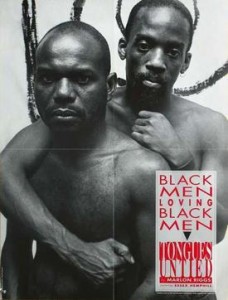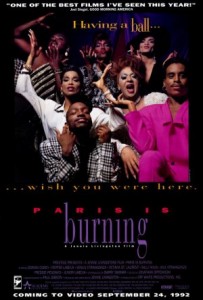Both “Paris is Burning” (1990), a documentary film by Jennie Livingston, and “Tongues Untied” (1989), a semi-autobiographical docufilm by Marlon Riggs explore the communities of transgender and gay people of color and its members’ efforts to reconcile racial and sexual identities.
Both films are groundbreaking in their portrayal of the difficulty of exploring various identities while living under the scrutiny of white, patriarchal society. Via the pageantry and pomp of the drag and ballroom scene in New York in the 80s and 90s, “Paris is Burning” explores gay Black, Latino, and transgender communities, as its members confront issues of race, gender, and sexuality. In interviews, often melancholic, the documentary participants (i.e. Pepper Labeija, Dorian Corey, & Angie Xtravaganza) often profoundly muse on lives plagued by familial, romantic, and societal rejection based on their sexuality.
Each speaks candidly about homelessness and ostracization, and how ballroom scenes offered places of refuge, kinship, and security. They too admit how
such arenas allowed them to escape realities and act out desires to attain a more affluent, Eurocentric standard of living. “Paris is Burning” has been legitimately critiqued for being more exploitative than politically challenging. Albeit a valid point, the film retains some cultural value.
“Tongues Untied” melds  narrative accounts via its director, Marlon Riggs, with fictional vignettes and interpretive poetry that represent a collective yet varied and mutable black, gay identity. The docufilm focuses primarily on gay black men (e.g. Essex Hemphill, Joseph Beam, Craig Harris and Riggs himself) , who also openly and unapologetically confront the ugly heads of racism and homophobia. Scenes of clips from homophobic stand up routines (e.g. by Eddie Murphy) and of the Civil Rights Movements serve to combat negative stereotypes and link the struggles of black, gay men with an historical legacy of resistance. Undoubtedly, “Tongues Untied” is focused and political in its thrust, arguably more so than “Paris is Burning.” Unlike Livingston, Riggs chooses not only to depict men stymied under the weight of white supremacy, but also takes the system to task, illustrating instances of fierce opposition. One such oppositional method is the refutation of silence preluded by the film’s title. Riggs directly challenges this inclination towards silence, not in a way that begets shame (he focuses his critique on a society that promotes and demands speechlessness), but rather one that privileges the power of black, gay men’s voices. Undoubtedly, herein lies the revolutionary mark of “Tongues Untied.”
narrative accounts via its director, Marlon Riggs, with fictional vignettes and interpretive poetry that represent a collective yet varied and mutable black, gay identity. The docufilm focuses primarily on gay black men (e.g. Essex Hemphill, Joseph Beam, Craig Harris and Riggs himself) , who also openly and unapologetically confront the ugly heads of racism and homophobia. Scenes of clips from homophobic stand up routines (e.g. by Eddie Murphy) and of the Civil Rights Movements serve to combat negative stereotypes and link the struggles of black, gay men with an historical legacy of resistance. Undoubtedly, “Tongues Untied” is focused and political in its thrust, arguably more so than “Paris is Burning.” Unlike Livingston, Riggs chooses not only to depict men stymied under the weight of white supremacy, but also takes the system to task, illustrating instances of fierce opposition. One such oppositional method is the refutation of silence preluded by the film’s title. Riggs directly challenges this inclination towards silence, not in a way that begets shame (he focuses his critique on a society that promotes and demands speechlessness), but rather one that privileges the power of black, gay men’s voices. Undoubtedly, herein lies the revolutionary mark of “Tongues Untied.”
Many comparisons have and continue to be drawn between the two films, with respect to representation of gay and transgender communities. bell hooks’ commentaries on the “gaze” and “subjectivity” are good entry points to discuss this issue. Interestingly, hooks discusses “Paris is Burning” in her book Black Looks: Race and Representation. She writes,
“(…) Jennie Livingston approaches her subject matter as an outsider looking in. Since her presence as a white/lesbian filmmaker is “absent” from Paris Is Burning, it is easy for viewers to imagine that they are watching an ethnographic film documenting the life of black gay “natives” and not recognize that they are watching a work shaped and formed by a standpoint and perspective specific to Livingston.”
Livingston, albeit a lesbian woman, operates from a place of privilege as a white woman. And, her racial and social status, though it should not discredit her or deem her incapable of exploring a culture outside her own, should call into question intent and the adequacy of her representation. Yes, Livingston sought to give voice to a particular community. However, her method becomes problematic considering it does not allow “subjects” to negotiate the terms of their own representation. They speak on their experiences and struggles, joys and pains, yes. However, they relinquish substantial ownership over the telling of their stories. Thus, they do not even retain any centrality in the work as it were. That these men and trans women fell back into relative obscurity post-film further elucidates the reality of their marginalization.
On the other hand, Riggs intentionally positions black, gay men centrally in “Tongues Untied.” Worthy of consideration is the holistic picture presented by Riggs and his cohort. Inherent in the film is a clear beginning, a journey that ebbs-and-flows, and an ending that is not altogether complete, but unmistakably hopeful. In the end, Riggs, having reflected on intense pain and internal conflict, remarks, “Whatever awaits me, this much I know: I was blind to my brother’s beauty, and now I see my own.” Unlike “Tongues Untied”, “Paris is Burning” is more fragmented, and the totality of experiences of gay men of color goes unaddressed. That TU is both created for and composed by black men undergirds and reaffirms its closing remark, “Black men loving black men is the revolutionary act.” —Keith Freeman
_______________________________________
Works Cited
hooks, bell. “Is Paris Burning?” Black Looks: Race and Representation. New York, NY: South End Press, 1992. 145-156. Print.
Paris is Burning. Dir. Jennie Livingston, 1990. Film.
Tongues Untied. Dir. Marlon Riggs, 1989. Film.

Thanks for sharing your thoughts on chicas. Regards